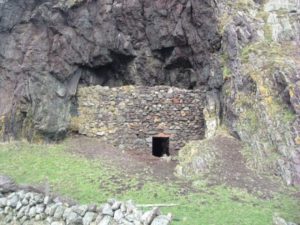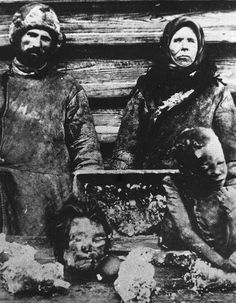By Sue Coletta
Whenever I’m plotting a new novel, I read a lot of true crime stories for inspiration. I may even steal character traits from one real world serial killer or victim and combine them with another. Reading triggers the muse to fire off plot, character, and subplot ideas. Somedays, though, the stories are almost too bizarre to believe. In which case, I’ve merely entertained myself for a while. Nonetheless, I wouldn’t call it wasted time, because true stories have a way of worming into our subconscious mind. When we’re in the writing zone, these alleged “useless facts” can morph into an intriguing scene that we never expected. Don’t you love when that happens?
With that in mind, I pose the following question to you, my dear TKZers. Did you know serial killing families existed? I’ve written about them before on my blog, as well as serial killing couples, which aren’t as rare.
 Wes Craven found inspiration for his 1977 slasher film The Hills Have Eyes when he read about the horrors of one particular family of serial killers — the Sawney Bean clan. This is their story. (Did anyone else hear Law & Order’s theme song when they read that line?)
Wes Craven found inspiration for his 1977 slasher film The Hills Have Eyes when he read about the horrors of one particular family of serial killers — the Sawney Bean clan. This is their story. (Did anyone else hear Law & Order’s theme song when they read that line?)
In the times of King James I, Mr. and Mrs. Sawney Bean transformed Bennane Cave, by Ballantrae in Ayrshire, Scotland, into their home. Long, twisting tunnels extended for more than a mile underground. The cave also featured several side passageways to accommodate a growing family. And grew they did. Over the years they created their own army of psychopathic cannabals.
Opposed to getting a job to support his new bride, Sawney Bean resorted to robbery. On the lonely back roads that connected the villages, he’d lie in wait for travelers to pass by. Townsfolk believed the roads were haunted due to the massive amount of disappearances.
A budding serial killer stalked those streets.
Bean’s sole reason for escalating to murder was to not leave witnesses. But then, Agnes, his wife, had an even sicker idea. If they butchered their victims, their remains could provide a high-protein diet, which had the added benefit of evidence disposal. Their relationship had already forced them to flee from their homeland in northern Scotland, after locals repeatedly made accusations of Agnes being a witch, claiming she’d been involved in human sacrifice and conjuring demons.
Over the years Sawney and his wife had fourteen children — all as twisted and evil as their parents — who became an army of serial killing cannibals.
During the next two decades, through incest, the children bore more children, who refined the art of murder and cannibalism, often salting and pickling human flesh. According to the Bean family ledger, found many years later, these incestuous acts brought Bean and Agnes a total of 18 grandsons and 14 granddaughters, now bringing the Bean clan to a total of 48 inbred, cannibalistic monsters.
Decaying body parts washed up on the beaches surrounding Bennane cave. Which prompted massive search parties. But no one thought to check the cave.
In about 1430 A.D., fate intervened when the Bean army — who had split into several small groups to hunt — attacked a man and his wife while on their way home from the fair. Half the Bean clan dragged the woman off her horse and had already disemboweled her before the other half of the group had a chance to wrestle the man to the ground. Fighting for his life, the distraught husband trampled several members of the Bean clan with his horse. This caused such a commotion a group of twenty bystanders came to his rescue.
During an all-out war, the Bean clan found themselves outnumbered for the first time in their pathetic lives. They retreated to the cave, leaving behind the mutilated remains of the man’s wife and a score of witnesses. The surviving victim was taken to the Chief Magistrate of Glasgow to tell his tale. With the longest missing persons list the country had ever seen, they reported to King James I, who arrived in Ayshire with his own army of 400 men and a pack of dogs.
Together with several hundred volunteers, another search was underway. Yet again, no one thought to search the cave. Until one cadaver dog alerted at the entrance.
Nothing could have prepared them for the horrors inside. The Bean family lived in that cave for 25 years. In total, the number of missing persons during that time is said to be over 1000.

Bennane Cave
Torches in hand and swords drawn, the army soldiered into Bennane cave and into the mile-long twisting passageways to the inner sanctum of the Bean lair. Dank cave walls held row after row of human limbs, heads, and torsos displayed like the window of a butcher shop. Bundles of clothes, jewelry, and picked-clean bones littered the ground.
A fight broke out between the King’s Army and the forty-eight Bean members, resulting in the arrest and apprehension of Sawney Bean and his kin.
Their crimes were so heinous that normal channels weren’t enough, so King James I sentenced them all to death. Twenty-seven Bean men were left to exsanguinate after executioners disarticulated their limbs. The twenty-one Bean women were hung, staked, forced to watch their male kin bleed out, and finally. set ablaze. Through the entire ordeal not one member of the Bean family showed any sign of fear or remorse. Instead, they spit obscenities toward their captors.
Until the moment Sawney Bean drew his final breath, he repeated one continuous phrase, “It isn’t over, it will never be over.”
Legend says, one of the daughters escaped during the fight with the King’s Army and a local family adopted her. At seventeen years old, she married and had a son. In hard times they also killed and cannibalized to stay alive. When the villagers caught wind of their gruesome activities they hung the Bean daughter and her husband, but not before her son escaped to America, settling what was then known as Roanke Island. The entire colony later disappeared without a trace.
Legend also says that if you sit under the hanging tree in Scotland, you can still hear the Bean daughter’s bones scrape against the bark.
I’ll end this post the same way it began. Where do you find inspiration?

You’ve made a great case for going VEGAN.
Wow. You can’t (or shouldn’t) make this stuff up,
I find inspiration in a number of ways. Stories from the news (sometimes obscure) that trigger my writer brain usually get into my story file. I like to include a twist on current events to make the plot seem plausible, usually something that is provocative.
I let my writer brain stew on a few notions until a find way to tie things together, like Jim’s post yesterday on “domestic thriller.” I had random, unconnected news that didn’t connect until his definition triggered a cohesive plot idea and it blended with another element I had in the back of my mind.
A friend shared a personal story about her daughter that she thought would make a good book. I had originally thought that could be a standalone, but when I matched that idea with my new ones, it made more of a thriller.
Plot ideas are mushy until you find how to mold them into something visceral with the right emotional impact & personal conflict. Then it all seems to rush together as if it had always been there, waiting for you and your special 3-D glasses to see it.
Vegan. Hahaha. You kill me, Jordan.
Jim’s post triggered ideas for me, too. Perhaps I should’ve said TKZ is the perfect place to tickle the muse. Sounds like your new thriller is melding together nicely. You go, girlfriend!
“Plot ideas are mushy until you find how to mold them into something visceral with the right emotional impact & personal conflict. Then it all seems to rush together as if it had always been there, waiting for you and your special 3-D glasses to see it.” <-- Yes, yes, triple yes!
Add my triple yes! Jordan, you perfectly expressed that wonderful click-into-place feeling. As the A Team used to say: “I love it when a plan comes together.”
Best feeling ever! Well, that and typing The End. 🙂
Music often is the key for me. I’ve found plot nuggets in three rock/pop songs. J. Geils “Monkey Island” gave me “Island of Bones.”. The Zombies’ “She’s Not There” gave me the stand alone of the same name. The Stones’ “Too Much Blood” led me to my stand alone “The Killing Song.”
My post tomorrow talks a little about my current struggle to find the right “door” into my next book. Yesterday, I was listening to some classic music (Ravel piano concerto), which led me to a video of the pianist Helene Grimaud. Watching the subtle but powerful interplay between Grimaud and the orchestra conductor finally gave me an idea for my opening.
You never know where it will come from. Thank God it does.
Music generates ideas for me, too, Kris. I based my last serial killer around Ozzy Osborne’s video for “No More Tears.” By the time I finished the book I was so sick of the song. Conversely, certain songs warm me with memories of scenes I wrote in the past. I love that about music.
Looking forward to your post tomorrow.
Here’s an interesting fact I learned recently. The place in the brain that triggers music to take us back to specific dates and times is the same part of the brain where headaches strike. Thus, listening to music has the ability to cure headaches.
huh…
That makes sense in an odd sort of way.
By the way, I had heard of the Beans but had never heard the whole gory details. Geez…
Doesn’t it? I’ve tested the theory. For me, music helped my headache about 75% of the time. Not bad odds.
I know, right? The Beans were a gruesome bunch.
Thank you (I think) in advance for tonight’s nightmares, Sue. And thanks also for what is possibly a first documented historical reference to the use of cadaver dogs.
Nice catch, Debbie. Never considered that.
Since the Beans lived a hop and a jump from my ancestors in Scotland (Argyll), and knowing the Scots could be a vicious lot (except for my kin), I had to Goggle for more information about the Beans. Some say their story is fact. Others say it’s legend — the Scots weren’t loved by the English and so the tea-drinkers liked to demonize them whenever possible. Either way — true or utter lie– the story is fascinating reading. Here’s what the BBC had to say in 2013:
http://www.bbc.com/news/uk-scotland-21506077
Do you know if the article was quoting Dr. John Yeoman? He was a friend and widely respected in the writing community. That said, it’s extremely difficult to verify events that happened in 1430 A.D. without some sort of skepticism. If a picture paints a thousand words, this image helped to push me toward the true story camp, but I’m sure “facts” have been stretched over time.
The article quoted historian Dr. Louise Yeoman (she’s pretty interesting, too).
The Bean story reminds of the line from The Man Who Shot Liberty Valance — “When the legend becomes fact, print the legend.”
Gee, I’m sorry. I didn’t notice Dr. Yeoman’s first name. Thanks for the clarification.
History provides my inspiration – though not perhaps on the level of ‘eww’ that the Bean story provides!! I often find research for one book gives me ideas for another and another:)
Ha! This story is filled with the eww factor. 🙂 I agree, Clare. Reading in our chosen genre is one of the best ways to find inspiration.
THIS STORY MADE MY DAY.
True crime stories and artwork are my favorite inspirations.
I’m so glad, Laura! xoxo I haven’t considered artwork, but I can see it pleasing the muse.